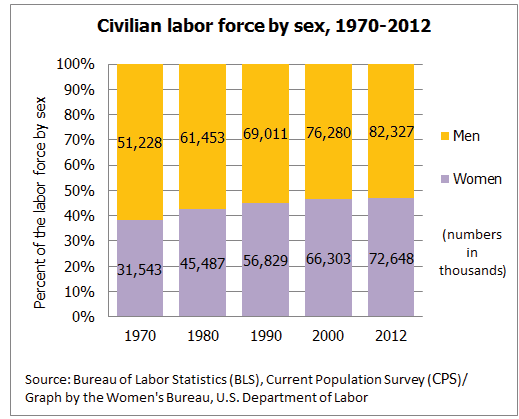
Syda Productions/Shutterstock.com
In General, Modern Offices Aren't Designed for Women
It’s not just A/C: Despite women having made huge gains in the labor force, office infrastructure hasn’t caught up.
On Monday, the Internet went wild over a new study about ice-cold office temperatures. After all, what desk jockey can’t relate to the sensation of shivering indoors when it’s a solid 40 degrees hotter outside?
The study, published Monday in the journal Nature Climate Change, reported that the ideal workplace temperatures—which hover between 68 and 76 degrees Fahrenheit—were calculated in the 1960s based on the model of a 40-year-old, 154-pound man. What the authors found is that the formula doesn’t account for metabolic differences that impact the way women experience temperatures.
The chatter quickly turned to a battle-of-the-sexes theme. A building physicistquoted in The New York Times pulled the cleavage card, and wondered if plunging necklines are to blame for women shivering in cardigans. (“The cleavage is closer to the core of the body,” he said. “I wouldn’t overestimate the effect of cleavage, but it’s there.”) The New Yorker issued a chronicle of “the sexist history of room temperature.” But when it comes to sexist office infrastructure, A/C is only part of this story.

Women’s participation in the workforce has steadily increased since the era when refrigerated air was standardized in office buildings. Female employees made up 47 percent of the workforce in 2012, up from 38 percent in 1970, according to the Bureau of Labor Statistics. In 2013, 57.2 percent of working-age women and 69.7 percent of working-age men were in the labor force. But office buildings haven’t necessarily caught up with the times.
If our A/C standard is set by this stereotypical idea of a male businessman from the 1960s, what other vestiges of former workplace infrastructure are still hanging around?
Lack of places to breastfeed
A 2010 amendment to the Fair Labor Standards Act requires employers to offer breastfeeding mothers ample break time to pump. Under this law, lactating moms must be able to retreat to “a place, other than a bathroom, that is shielded from view and free from intrusion from coworkers and the public.”Lactation rooms don’t have to be permanent (for instance, pod designs are feasible), and necessarily have to be cushy—but imagine trying to find a spot to hook up a breast pump in a closet, or cramming expelled milk into a communal fridge. The Office on Women’s Health launched the Breastfeeding at Work Project to connect employers with resources.
Too few bathrooms
Twenty years ago, Linda Lim, a professor at the University of Michigan’s Ross School of Business, had trouble finding a women’s bathroom in her 1950s-era office building. “We had to walk a long way,” she says. Lim notes that the disparity between men’s and women’s bathrooms made sense for buildings constructed on academic campuses during the 1950s, when there were fewer female professors and students, but is outdated now that female students outnumber male ones.
Lim’s new office, in a building constructed in 2008, better reflects her current workplace demographics. Each wing of a given floor has four bathrooms: two women’s, one men’s, and one unisex.
Non-ergonomic work stations
Female workers are more likely than men to sustain work-related carpal tunnel syndrome or tendonitis. Women represent nearly two-thirds of all reported CTS cases, the BLS reports.
So how can women prevent aggravating the nerves that flare up in CTS? Avoid flexing at the wrists. Maintain straight posture. Slumping or slouching can roll the shoulders forward and compress nerves from the shoulders and neck. Invest in an ergonomic setup.
Oh, and, unfortunately, the Mayo Clinic suggests that there’s a correlation between cold environments and hand stiffness and pain. Maybe you do need to turn down the A/C, after all.
(Top image via Syda Productions/Shutterstock.com)






